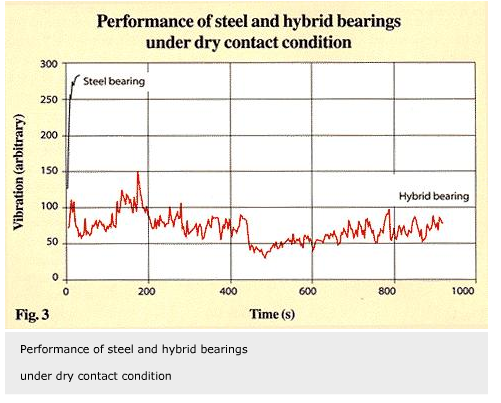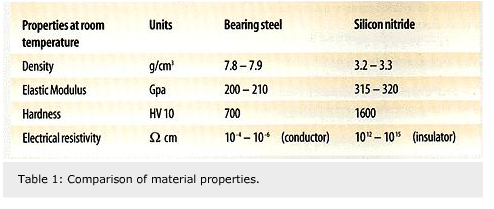
Evaluating hybrid bearings for general applications
Opportunities are now opening up for hybrid bearings – incorporating silicon nitride balls rather than steel ones – in general purpose machine applications. Applications include electric motors, gearboxes, power tools, pumps and compressors.Hybrid precision bearings which combine silicon nitride balls and steel rings have already proved their worth in high-speed applications.
Opportunities are now opening up for hybrid bearings – incorporating silicon nitride balls rather than steel ones – in general purpose machine applications. Applications include electric motors, gearboxes, power tools, pumps and compressors.Hybrid precision bearings which combine silicon nitride balls and steel rings have already proved their worth in high-speed applications.
To date, the major market has been in high-speed precision machine tool spindles using angular contact ball bearings.
General purpose machines increasingly require the kind of performance characteristics delivered by hybrid designs. The main benefits are higher speed operation, reduced vibration and longer service life. At the same time, silicon nitride ball manufacturing is also becoming more economical.
Performance testing
As silicon nitride balls will inevitably move into “high end” deep groove ball bearing applications, a thorough understanding of the operating characteristics of hybrid bearings is required.
Lubrication is particularly important. Machine tool hybrid designs are frequently oil lubricated, using oilspot or oil circulation systems. Deep groove ball bearings, however, are generally grease lubricated.
A series of tests devised within SKF confirm the superior properties of silicon nitride balls compared to conventional bearing configurations. Four types of behaviour are discussed here: electrical resistivity, wear, dry running and grease lubrication.
Electrical resistivity
Being a ceramic, silicon nitride is a material with high resistivity, and can be considered as an insulator. For a bearing arrangement, electrical conduction through a bearing is undesirable as it leads to bearing damage (washboarding, false brinelling). Calculations confirmed that hybrid bearings have a resistivity comparable to that of silicon nitride itself (table 1). These insulating properties of the material, would make it unneccessary to make special provisions for bearing insulation, e.g. in traction motor applications.
Wear test
Wear performance of hybrid bearings was tested under contaminated conditions using SKF COLETTE test machines. These machines simulate gearbox bearing lubrication by adding hard particles to oils. The wear behaviour of test bearing lots over 100 hours is assessed by the increase in bearing clearance or the weight loss of the bearing components (the inner rings, outer rings and balls) under pre-defined contaminated oil conditions.
Figure 1 shows the axial displacement of the test bearings as a function of time. With steel bearings, these tests result in a considerable increase in the clearance and wear of the inner ring (fig. 2). By contrast, hybrid bearings possess much higher wear resistance, outperforming the all-steel bearings.
Dry running tests
Hybrid precision bearings generate a much lower friction, and thus operate at lower temperatures than steel bearings under very high speed conditions (ndm > 1 million). This has been attributed to the smoother surface and the smaller contact ellipse of the silicon nitride balls which results in a lower spin-to-roll ratio for hybrid bearings.
Existing data also indicates the superior scuffing resistance of silicon nitride-metal pairing under pure sliding conditions.
Figure 3 illustrates the performance of steel and hybrid bearings (bearing 6204) carried out under “virtually” dry contact and low load conditions at speeds of 1500 r/min. With steel bearings, excessive vibration (indicating the onset of scuffing) was recorded at the start of the test. Hybrid bearings, however, run quite steadily over a relatively long period of time. These results clearly imply a superior “lubrication” performance of hybrid bearings under dry (no oil) conditions.
Grease lubrication
The SKF Engineering & Research Centre (ERC) has established an extended study to review the comparative performance of grease lubricated hybrid bearings against steel ones, using SKF R2F test machines. This project was split between ERC in the Netherlands and the Institute of Technology in Darmstadt, Germany. The test conditions selected were severe: an operating temperature of 140 °C at a speed of 20,000 r/min. At this speed and temperature, grease life is often the determining factor for overall bearing life, although cages can also play a significant role. A grease based on polyurea thickener and synthetic base oil was selected for the test. Cage types tested were riveted sheet steel, riveted phenolic and polyamide (snap-type). All bearings were run with shields. Due to interference with the rivets on the phenolic cages, however, conventional shields had to be substituted by “Nilos” rings on these test bearings.
Some effects
The high speed used in the tests (ndm ³ 670,000) means that the forces generated by centrifugal acceleration acting on the cage mass are significant. In high speed applications, silicon nitride balls have two important benefits when compared to their steel equivalents.
Firstly, for a given size, silicon nitride balls have only 40% of the mass of steel balls. Secondly, silicon nitride has a modulus of elasticity 50% higher than that of steel (table 1), which means that the ceramic balls are stiffer than their steel counterparts. This greater stiffness, coupled with the reduced mass, results in much smaller contact areas between the ceramic ball and raceway or cage pocket.
In addition to these essentially mechanical benefits, there is also lower adhesion between silicon nitride and steel when compared to steel against steel. Lower adhesion places a much lower demand on lubrication; a hybrid bearing can work quite happily in a lubrication regime that would, for a steel bearing, be at the starvation level or dry-running condition (fig. 3).
At elevated temperatures (above the recommended 120 °C) polymeric cage materials can suffer softening and other weakening effects. Chemical interactions may take place between the grease and polymeric cage materials. Finally there is the grease life itself. All greases will age, and high speed and high temperature applications are particularly demanding conditions under which to achieve long grease life, so bearing seizure during testing was expected and occurred, although not for all bearing types.
Results
The hybrid bearings lasted up to six times longer than their steel equivalents with the test grease employed. There was no significant difference in the grease life of hybrid bearings with three different cage types (fig. 4). During testing, the polyamide cages suffered badly because of the high test temperature, though they lasted better in the hybrid bearings than initially expected. Phenolic cages are very stiff and the material can be machined precisely, so it is preferred for cages in high-precision ball bearings. In the test bearings, however, the stiffness of phenolic material suffered from high cage pocket wear. The metallic (steel cages) lasted best of all. Steel cage failure occurred in both steel and hybrid bearings, but at a much lower rate than that of the polyamide or phenolic cages.
Applications
One of the first major uses of hybrid deep groove ball bearings is in the Atlas Copco high-speed hand grinder. This device also applies the SKF auto-balancing principle which reduces vibration levels (see Evolution 2/1994). This is an example of high customer value, as without the hybrid bearings it would not have been possible to create the product.
As demonstrated, hybrid bearings can increase service life and add value to customers’ products thanks to superior performance when compared to traditional steel bearings in poor lubrication or dry conditions. In addition, hybrid bearings offer low wear in contaminated situations, electrical insulation and longer grease life.
George Wan,
SKF Engineering & Research Centre B.V.,
Nieuwegein, The Netherlands







